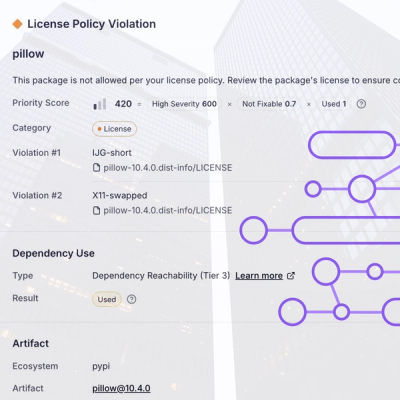
Research
/Security News
Critical Vulnerability in NestJS Devtools: Localhost RCE via Sandbox Escape
A flawed sandbox in @nestjs/devtools-integration lets attackers run code on your machine via CSRF, leading to full Remote Code Execution (RCE).
API testing made simple
npm install api-test --save-dev
Create a test file 'test/api-test/sample.md' to test the 'item/get' endpoint, like this:
# item/get
## Setup
### item in items
name: 'Salad'
price: 500
## Invalid request
### Post
randomId()
### Out 400
error:
code: 200
## Valid request
### Post
item.id
### Out
name: item.name
price: item.price
And in your mocha testing code:
require('api-test')('test/api-test', {
mongoUri: 'mongodb://localhost:27017/api_test',
baseUrl: 'http://localhost:8000/'
})
Testing is, at the same time:
This module tries to solve this by making testing code more concise and unifying testing and documentation.
Markdown was choosen because it's easy to write/read and it's not code!
A test is divided in two parts:
This is an optional section called 'Setup' that lets you insert documents, declare variables and clear mongo collections to prepare the database before the test cases run.
The syntax is simply:
### _docName_ in _collection_
_docDescription_
At the first insertion in a collection, it will be cleared. This is important to make every test isolated. You may refer to this object by its docName.
The syntax for docDescription is described bellow.
Most of times, documents have a base strucuture with some default fields. You do not need to repeat yourself in this case, see the option defaultDocuments bellow.
The syntax is simply:
### Clear _collection_
Use this only when you won't insert any document in that collection, but want it to be cleared.
All documents in that collection will be removed, indexes will be kept
You can declare and define a variable to use in test cases, db insertions and more:
### _varName_ is
_variableContent_
This will make varName available to every following object block.
A test case has three optional sections:
Post: the JSON body to send by POST. Must start with a header like ### Post [_url_]. Default: empty JSON object {}. The url is optional and defaults to the test nameOut: the expected JSON output. Must start with a header like ### Out [_statusCode_]. Default: no output checking. The statusCode is optional and defaults to 200Finds: optional DB assertions. Must start with a header like ### Find in _collection_In all cases, the syntax is described bellow
By appending (skip) to a test case name (see an example) it will be simply ignored. This puts them in a pending state, and is favoured over removing tests which you may forget to add back again.
You can also append (skip) to a test file header (see an example) to skip the whole file.
The syntax was designed to be concise and expressive. The values will be eval'ed as normal JS with a context with special variables (see default context bellow).
The object can be a simple JS value, like:
new Date
Or an object with one property by line and tabs used to declare sub-objects:
user:
name:
first: 'Happy'
last: 'Customer'
age: 37 + 2
country: 'cm'.toUpperCase()
Or mixins, like:
user with name.first: 'Unhappy'
Learn more about the syntax in the file value-syntax.md
ObjectId(): the mongo object id constructorrandomId(): return a random mongo-id as a 24-hex-char stringpost: the request body of the current test caseout: the response body of the current test caseprev: an object wity keys:
post: the request body of the previous requestout: the response body of the previous requestmongoUri: the mongo uri to connect to. The hostname SHOULD be 'localhost' and the db name SHOULD contains 'test'. If not, the code will ask for confirmation. This protects one from dropping production data, since the tests automatically clear collections, before inserting docs.baseUrl: the base API url. Every request url will be composed from this base and the test name.name: (optional) the test name (given to root describe(name, ...) call)defaultDocuments: (optional) the default structure for documents in each collection. See issue #1 for detailsdescribe, it, before: (optional) the mocha interface. Defaults to global mocha functionscontext: (optional) define your own variables/functions accessible to object definitionsrecursive: (optional) whether to look for *.md files inside subfolders (default: false)strict: (optional) whether the output check should be strict and complain about unexpected keys (default: true)ca: (optional) CA certificate (useful when using a self-signed certificate in the server)ignoredFindKeys: (optional) document keys to ignore in finds (default: ['_id', '__v'])filterFile: (optional) a function that will be called for every file and should return true if this file should be parsedindex.jsIf you don't know the exact value for an API response or field in the collection, you can check for its type:
## Testing types
### Post
...
### Out
token: String
### Find in users
password: String
lastLogin: Date
The valid type values are: String, Number, Boolean, Object, Array, Date, RegExp, ObjectId.
You can use custom context to help writing tests. All default context variables and methods will still be accessible (unless overwritten).
For example: if all endpoints return errors like this: {error: {code: _code_, message: _aDebugString_}}, you can pass as context:
options.context = {
error: function (code) {
return {
error: {
code: code,
message: String
}
}
}
}
And then write a test case like this:
## Invalid email should give error 200
### Post
user:
email: randomEmail()
### Out
error(200)
Instead of repeating yourself with:
error:
code: 200
message: String
See more test examples in the folder test/api-test
Run npm test in the project root folder.
FAQs
API testing made simple
The npm package api-test receives a total of 22 weekly downloads. As such, api-test popularity was classified as not popular.
We found that api-test demonstrated a not healthy version release cadence and project activity because the last version was released a year ago. It has 3 open source maintainers collaborating on the project.
Did you know?

Socket for GitHub automatically highlights issues in each pull request and monitors the health of all your open source dependencies. Discover the contents of your packages and block harmful activity before you install or update your dependencies.

Research
/Security News
A flawed sandbox in @nestjs/devtools-integration lets attackers run code on your machine via CSRF, leading to full Remote Code Execution (RCE).

Product
Customize license detection with Socket’s new license overlays: gain control, reduce noise, and handle edge cases with precision.

Product
Socket now supports Rust and Cargo, offering package search for all users and experimental SBOM generation for enterprise projects.